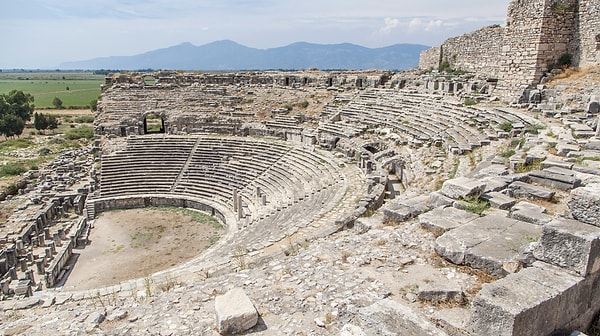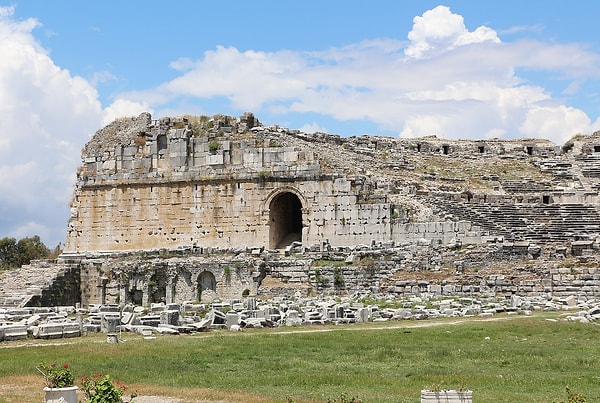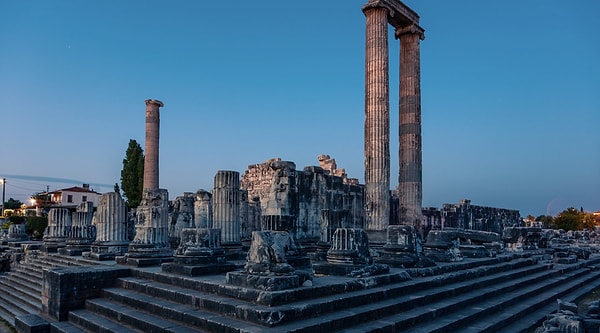Explore Miletus Ancient City: Aegean’s Hidden Archaeological Site in Turkey
If you are looking for a unique ancient city where history, philosophy and architecture meet, the ancient city of Miletus is for you. Located in the Didim district of Aydın, this historical city is notable not only for its impressive ruins but also for being the birthplace of Western philosophy. Miletus is one of the most important cultural heritages of the Aegean Region with its history dating back thousands of years, its magnificent theatre, ancient buildings and the natural beauty of its surroundings. In this comprehensive travel guide, you will find answers to all your questions, such as how to get to the ancient city of Miletus, which buildings are must-sees, what the museum and environmental routes offer, and embark on a historical journey.
History of Miletus: A Civilisation Steeped in Wisdom

Miletus has a history dating back to 2000 BC. It first interacted with the Minoan and Mycenaean civilisations, and then was established as a Greek colony by the Ionians. Since the 7th century BC, it has made great progress in trade, maritime, science and philosophy and became one of the intellectual capitals of the period.
Miletus is known as the place where natural philosophers such as Thales, Anaximandros and Anaximenes grew up. With this feature, it is considered one of the cities where Western philosophy was born. In addition, the architect Hippodamos made history with the grid plan model he implemented in Miletus with his systematic approach to urbanism.
The city, which fell under Persian, Alexander the Great, Roman and Byzantine sovereignties, left different traces in each period and maintained its importance for a long time. However, the filling of the harbour over time with the alluvium carried by the Büyük Menderes River reduced the economic and strategic value of the cit,y and it was gradually abandoned.
Must-See Buildings in Miletus

The first building that greets you when you step into the ancient city of Miletus is the fascinating ancient theatre. With a capacity of 15 thousand people, this theatre, which was expanded during the Roman period, still impresses with its acoustics and architecture.
Just behind the theatre is the Delphinion, a sacred area dedicated to the god Apollo. Passing through here, you reach the agora of Miletus, which was the centre of both trade and social life.
Other buildings that you should definitely see during your trip are as follows:

Faustina Bath: This bath complex, built in the name of the Roman Empress Faustina, reveals the architecture and social life of the period.
Ilyas Bey Mosque: Rising among ancient ruins, this 15th-century monument dates from the Aydin Principality period and bears traces of Islamic influence in Miletus.
Temple of Serapis: Dedicated to the Egyptian cult of Serapis, this structure reflects the religious diversity of the Hellenistic period.
Byzantine Castle and Walls: These ruins, built during the last periods of the city, are important for understanding Miletus' defence strategies and the transformations it underwent.
Miletus Museum: Travel in Time with Ancient Artefacts

Many artefacts excavated from the ancient city of Miletus are exhibited in the Miletus Museum, located nearby. The museum has a very rich collection of artefacts brought from both Miletus and the surrounding ancient cities of Priene and Didyma. Sculptures, column capitals, sarcophagi and terracotta objects provide a better understanding of the history of the region.
Transportation Information: How to get to Miletus Ancient City?

Miletus Ancient City is located about 30 km from the Didim district of Aydın province. Balat, the nearest village, is right next to the ancient city.
For those arriving by private car, it is enough to turn towards Balat village on the Söke-Didim road. The road is asphalt, and transportation is quite easy. For those who want to use public transportation, it is possible to reach Balat by minibuses departing from Didim and Soke. During the summer months, tourist minibus services to Miletus also become more frequent.
Visiting Hours and Entrance Fee

The ancient city of Miletus is open to visitors at different times during the summer and winter seasons. It can be visited between 08:30 - 19:00 in summer (April - October) and between 08:30 - 17:00 in winter (November - March). The entrance fee is free for Museum Card holders, while visitors without a Museum Card can purchase a ticket for a nominal fee. It is recommended to consult the official sources of the Turkish Ministry of Culture and Tourism for the most up-to-date prices.
Travel Tips

There are no cafes or buffets in and around the ancient city. For this reason, it will be useful to bring your water and snacks with you. Also, sunscreen, hats and comfortable shoes should be preferred as it can be quite hot in the summer months. Since most of the area is open air, sunset hours are ideal for those interested in photography.
Places to Visit Around Miletus

After your visit to Miletus, you may want to explore other important ancient cities and natural beauties in the surrounding area:
Didyma (Didim Temple of Apollo): The centre of faith for the people of Miletus, this massive temple is only 20 minutes away. It was used as Apollo's oracle centre.
Priene Ancient City: 30 km away, this ancient city offers a spectacular view of the valley, with a well-preserved theatre and the Temple of Athena.
Bafa Lake and Herakleia: This region, where nature and history are intertwined, is ideal for camping, hiking and visiting ancient ruins.
Akköy and Mavişehir: Small villages on the way to Didim, known for their tranquil atmosphere and local markets.
The Best Time to Visit Miletus

The ancient city of Miletus can be visited at any time of the year, but the spring and fall months are preferable as they offer ideal weather conditions. In summer, the Aegean region can be quite hot, while in winter, the risk of precipitation can make sightseeing difficult.
Miletus is not only a collection of ruins of stone and marble, but also a civilisation where the foundations of thought and science were laid. Wandering around the ancient theatre and knowing that the first sprouts of philosophy blossomed here, imagining the social life of the Roman era in the Faustina Baths or touching objects from thousands of years ago in the Miletus Museum are the soul of this trip.
If you are travelling to the shores of the Aegean, you should definitely add the ancient city of Miletus to your travel list. Because this place tells not only about the past, but also about the legacy of the past to the future.
Keşfet ile ziyaret ettiğin tüm kategorileri tek akışta gör!

Send Comment